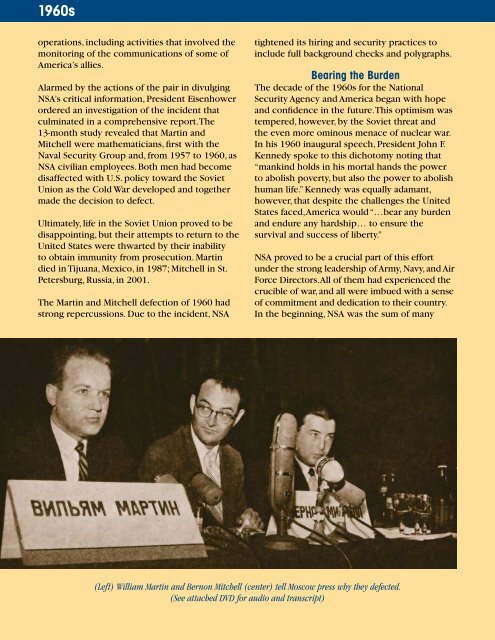National Security Agency - The Black Vault
National Security Agency - The Black Vault
National Security Agency - The Black Vault
- No tags were found...
Create successful ePaper yourself
Turn your PDF publications into a flip-book with our unique Google optimized e-Paper software.
1960s<br />
operations, including activities that involved the<br />
monitoring of the communications of some of<br />
America’s allies.<br />
Alarmed by the actions of the pair in divulging<br />
NSA’s critical information, President Eisenhower<br />
ordered an investigation of the incident that<br />
culminated in a comprehensive report. <strong>The</strong><br />
13-month study revealed that Martin and<br />
Mitchell were mathematicians, first with the<br />
Naval <strong>Security</strong> Group and, from 1957 to 1960, as<br />
NSA civilian employees. Both men had become<br />
disaffected with U.S. policy toward the Soviet<br />
Union as the Cold War developed and together<br />
made the decision to defect.<br />
Ultimately, life in the Soviet Union proved to be<br />
disappointing, but their attempts to return to the<br />
United States were thwarted by their inability<br />
to obtain immunity from prosecution. Martin<br />
died in Tijuana, Mexico, in 1987; Mitchell in St.<br />
Petersburg, Russia, in 2001.<br />
<strong>The</strong> Martin and Mitchell defection of 1960 had<br />
strong repercussions. Due to the incident, NSA<br />
tightened its hiring and security practices to<br />
include full background checks and polygraphs.<br />
Bearing the Burden<br />
<strong>The</strong> decade of the 1960s for the <strong>National</strong><br />
<strong>Security</strong> <strong>Agency</strong> and America began with hope<br />
and confidence in the future. This optimism was<br />
tempered, however, by the Soviet threat and<br />
the even more ominous menace of nuclear war.<br />
In his 1960 inaugural speech, President John F.<br />
Kennedy spoke to this dichotomy noting that<br />
“mankind holds in his mortal hands the power<br />
to abolish poverty, but also the power to abolish<br />
human life.” Kennedy was equally adamant,<br />
however, that despite the challenges the United<br />
States faced, America would “…bear any burden<br />
and endure any hardship… to ensure the<br />
survival and success of liberty.”<br />
NSA proved to be a crucial part of this effort<br />
under the strong leadership of Army, Navy, and Air<br />
Force Directors. All of them had experienced the<br />
crucible of war, and all were imbued with a sense<br />
of commitment and dedication to their country.<br />
In the beginning, NSA was the sum of many<br />
parts; however, over time it began to develop its<br />
own unique identity. In early 1963 NSA adopted<br />
a seal that proclaimed the <strong>Agency</strong> a component<br />
of the Department of Defense. Two years later,<br />
Lieutenant General Marshall S. Carter, USA, the<br />
new Director of NSA, wanted to emphasize that<br />
the <strong>Agency</strong> served the needs of the entire U.S.<br />
Government, even though it was subordinate<br />
to DoD. Consequently, he had a second seal<br />
prepared that incorporated this idea into the<br />
new design.<br />
Vice Admiral Frost<br />
In the fall of 1960, NSA would see its first U.S.<br />
Navy Director, Vice Admiral Laurence Frost. A<br />
native of Fayetteville, Arkansas, Frost was born in<br />
1902 and graduated from the U.S. Naval Academy<br />
in 1926. Frost, like the other early Directors, had<br />
seen war firsthand and had been awarded the<br />
Bronze Medal and two Silver Stars.<br />
Frost brought a wealth of experience in<br />
communications both at sea and in staff<br />
positions to his brief tenure as Director. After a<br />
dispute with the Pentagon, he stepped down as<br />
Director in June of 1962, three months before<br />
one of the most harrowing and dangerous<br />
moments in NSA and U.S. history.<br />
LEADERSHIP<br />
DIRECTORS<br />
VADM Laurence H. Frost, USN<br />
(November 60 – June 62)<br />
Lt Gen Gordon A. Blake, USAF<br />
(July 62 – June 65)<br />
Lieutenant General Blake<br />
Air Force Lieutenant General Gordon A. Blake<br />
replaced Frost. Like the previous occupants<br />
of his office, Blake was no stranger to combat.<br />
Blake gained valuable experience during<br />
World War II in operations communications<br />
and later in the field of research and<br />
development. His experience eventually led<br />
to his appointment as Commander of the Air<br />
Force <strong>Security</strong> Service. Blake’s wartime and<br />
service pedigree were valuable assets in his<br />
role as NSA Director. Shortly after he assumed<br />
the post, he would have to draw on every bit<br />
of his talents and experiences to assist the<br />
Nation in dealing with the harrowing series<br />
of events that would come to be known as<br />
the Cuban Missile Crisis.<br />
1960s<br />
LTG Marshall S. Carter, USA<br />
(June 65 – August 69)<br />
(Left) William Martin and Bernon Mitchell (center) tell Moscow press why they defected.<br />
(See attached DVD for audio and transcript)<br />
<strong>The</strong> Cuban Missile Crisis<br />
In the autumn of 1962, the United States faced<br />
its most serious crisis of the Cold War.<br />
DEPUTY DIRECTORS<br />
Dr. Louis W. Tordella (August<br />
1958 – April 1974)<br />
<strong>National</strong> <strong>Security</strong> <strong>Agency</strong> 60 Years of Defending Our Nation 31

















